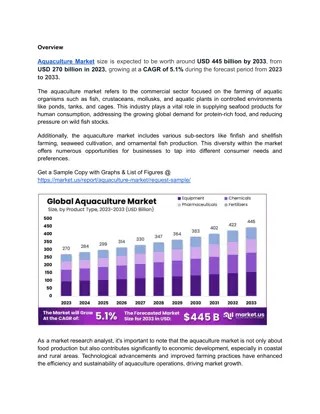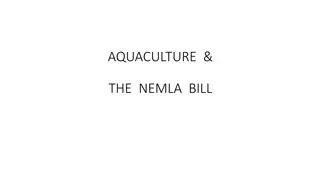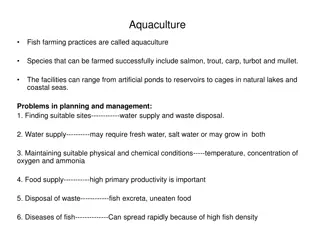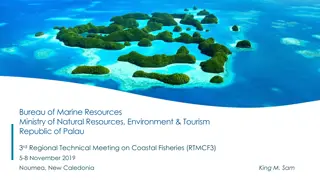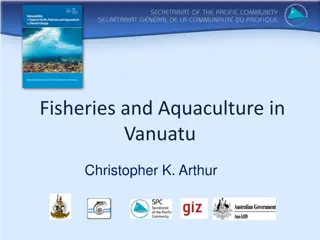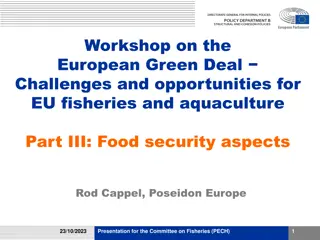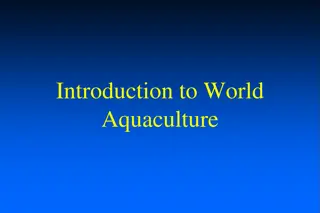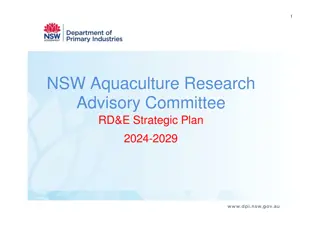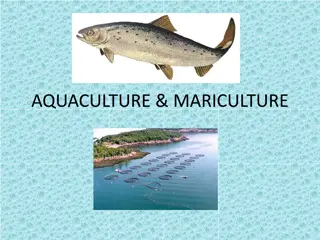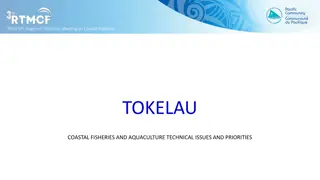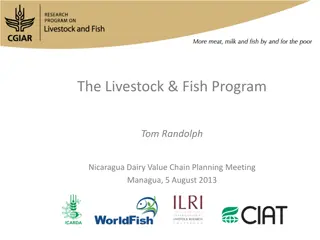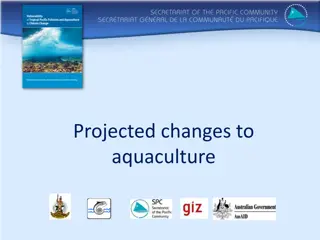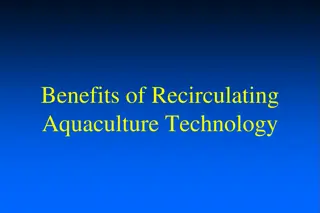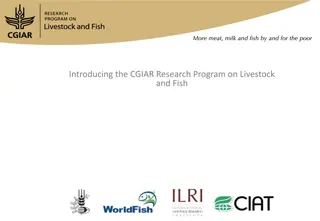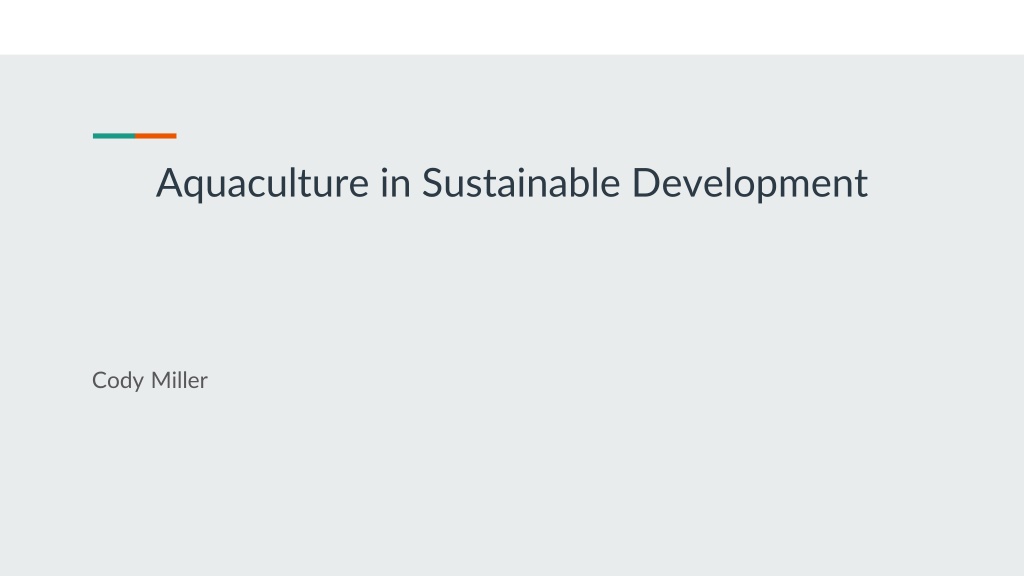
Sustainable Aquaculture Practices and Benefits
"Explore how aquaculture projects, both large and small scale, contribute to sustainable development by creating jobs, generating tax revenue, providing food security, and promoting community-based initiatives. Discover the potential of red drum aquaculture and new practices in the industry."
Download Presentation

Please find below an Image/Link to download the presentation.
The content on the website is provided AS IS for your information and personal use only. It may not be sold, licensed, or shared on other websites without obtaining consent from the author. If you encounter any issues during the download, it is possible that the publisher has removed the file from their server.
You are allowed to download the files provided on this website for personal or commercial use, subject to the condition that they are used lawfully. All files are the property of their respective owners.
The content on the website is provided AS IS for your information and personal use only. It may not be sold, licensed, or shared on other websites without obtaining consent from the author.
E N D
Presentation Transcript
Aquaculture in Sustainable Development Cody Miller
Red Drum Aquaculture Red drum aquaculture is the practice of raising red drum, a popular game fish, in captivity. Red drum are native to the Atlantic and Gulf Coasts of the United States, and they are a fast-growing species that can reach market size in as little as 18 months. Red drum aquaculture is a relatively new industry, but it has the potential to provide a sustainable source of seafood for the Gulf Coast region.
Large Scale Projects Creating jobs: Large-scale aquaculture projects can create jobs in a variety of fields, including production, processing, marketing, and sales. These jobs can benefit the community by providing a source of income for residents. Generating tax revenue: Large-scale aquaculture projects can generate tax revenue for the local government, which can be used to fund public services such as schools, roads, and hospitals. Attracting investment: Large-scale aquaculture projects can attract investment from businesses and individuals, which can help to stimulate the local economy. Providing a source of food: Large-scale aquaculture projects can provide a source of food for the local community, which can help to reduce food insecurity. Protecting the environment: Large-scale aquaculture projects can be designed to protect the environment by using sustainable practices such as closed-loop systems and waste management.
Small Scale Projects Providing a source of income: Small-scale aquaculture projects can provide a source of income for farmers and their families. Reducing poverty: Small-scale aquaculture projects can help to reduce poverty by providing a way for people to earn a living in rural areas. Improving food security: Small-scale aquaculture projects can help to improve food security by providing a source of fresh, local food. Increasing food diversity: Small-scale aquaculture projects can increase food diversity by providing a way to grow different types of seafood. Empowering women: Small-scale aquaculture projects can empower women by providing them with an opportunity to earn an income and participate in the workforce.
Community Base Projects Building community: Community-based aquaculture projects can help to build community by bringing people together to work on a common goal. Providing education and training: Community-based aquaculture projects can provide education and training in aquaculture, which can help to create a skilled workforce. Promoting sustainability: Community-based aquaculture projects can promote sustainability by using sustainable practices and educating the public about the importance of aquaculture. Protecting the environment: Community-based aquaculture projects can protect the environment by using sustainable practices such as closed-loop systems and waste management.
New Practices The introduction of new, non-traditional practices in aquaculture in the Charleston, SC area could best succeed and complement existing wild fisheries by: Using sustainable practices. New aquaculture practices should be designed to minimize environmental impact and avoid the use of harmful chemicals or pollutants. This could include using closed-loop systems that recycle water and nutrients, or using species that are not native to the area and therefore pose no threat to wild populations. Targeting underutilized species. There are many species of fish and shellfish that are not currently harvested commercially. By targeting these underutilized species, aquaculture could help to reduce pressure on overfished wild populations. Providing a local source of food. Aquaculture can help to reduce reliance on imported seafood, which can have a positive impact on the environment and the local economy.
Benefiting Through Community-Based Initiatives A community-based cooperative would benefit the community in a number of ways, including: Increased economic development:Aquaculture can be a profitable business, and a community-based cooperative would allow the community to share in the profits. This could help to boost the local economy and create jobs. Education and training: A community-based cooperative can provide opportunities for education and training in aquaculture, which can help to create a skilled workforce and boost the local economy. Community empowerment: A community-based cooperative can help to empower the community by giving them a say in how aquaculture is developed and managed. This can lead to a more sustainable and equitable aquaculture industry.
Possible Modification Through Using Low Tech for both Red Drum and World Atlas Charleston sites. Using low-technology systems that anyone could use would help this community aquaculture project in a number of ways, including: Reduced cost: Low-technology systems are typically less expensive to install and operate than high- technology systems. This can make aquaculture more accessible to communities with limited resources. Increased accessibility: Low-technology systems can be built and operated by people with a variety of skills and experience levels. This can make aquaculture more accessible to people who might not otherwise be able to participate. Increased sustainability: Low-technology systems are often more sustainable than high-technology systems. This is because they require less energy and water, and they produce less waste.
Low Tech Cont. By using low-technology systems, a community-based aquaculture project can be more affordable, accessible, and sustainable. This can help to ensure that the project is successful and that the benefits of aquaculture are shared by the entire community. Here are some specific examples of low-technology aquaculture systems that could be used in a community-based project: Small-scale pond aquaculture: This is a traditional method of aquaculture that uses small ponds to raise fish or shellfish. Aquaponics: This is a system that combines aquaculture with hydroponics, which is the growing of plants without soil. Integrated pest management (IPM): This is a system that uses a combination of biological, chemical, and cultural methods to control pests in aquaculture systems.


